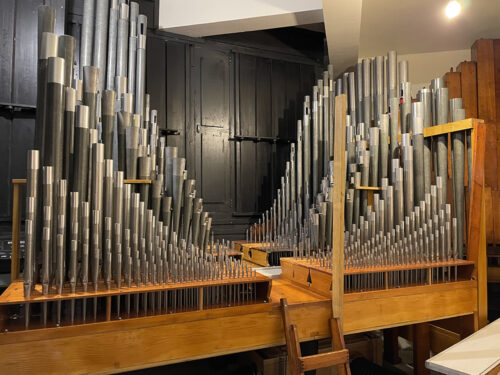WINDSOR TERRACE — When Immaculate Heart of Mary Parish’s 1932 Kilgen pipe organ began echoing and sounding out of tune more than a year ago, Father Ilyas Gill wanted to breathe new life into the majestic instrument. The organ’s 25 ranks of pipes, three bellows, valves, and chassis — which had been last repaired in 1968 — were worn out and even completely sealed in some spots.
The pipe organ cost about $350,000 to repair, with the funds coming from three different collections — an in-house collection for church repairs, the diocese’s Generations of Faith Capital Campaign, and a portion of pledges from the Annual Catholic Appeal. The organ repair was part of a larger renovation project at Immaculate Heart of Mary (IHM), which included restoring the church’s interior, refinishing the pews, and upgrading the WiFi. Another capital project for IHM in 2021 will repair the rectory’s elevator.
“People are very generous,” said Father Gill, who has been pastor at IHM for nearly six years. “I have never seen them put the church down. They always support the church.”
The pipe organ repair process took a little longer than anticipated. IHM parishioners were unable to hear it played for 11 months due to the mandated pandemic shutdown during the spring of 2020 and the time it took Peragallo Pipe Organ Company to rebuild the piece.
John Peragallo III, who helps head his family’s business, explained it took about a week to dismantle the church’s organ and three months to fix it in their New Jersey factory. Peragallo cleaned and reshaped 1,429 pipes (made of reed, metal, and wood) and placed them on a brand new chassis and console with five bellows. The organ finally returned to its Windsor Terrace home in January 2021 but needed four weeks to be reassembled and revoiced to the church’s acoustics.
“It still sounds like the original organ since it’s playing the original pipes from 1932,” Peragallo said, “but with all of this technology, you could do so many wonderful things these days — including transposing, playback and recording, and sequencing the pistons.
Modernizing the pipe organ has allowed organists to transpose the music — playing in one key signature and having the music come out in a different key signature to accompany singers who have either a higher or lower voice. IHM Music Director Connor Whelan noted that he’s been able to use different registers on the organ in the last month, as well as different pedals, while playing hymns during Sunday masses.

Peragallo also explained that organists can read sheet music on an iPad that’s connected to the instrument, thanks to today’s technology. This, he explained, allows them to turn pages with the tap of their toes while playing.
“Since it’s basically state of the art, it’s going to be good for another 60 to 70 years,” he said.
For Angie Hemulgada, who has been an IHM parishioner for more than 40 years, the new sound is music to her ears as she attends Mass almost every day.
“The organ is a big difference for the community, and the sound is totally different,” she said after the new organ made its debut on Jan. 17. “The feeling when you hear it is a different sound … very solemn, it gets to you.”
Deacon John Cantirino said this much-needed investment and improvement will elevate celebrations within the church.
“Music is important in the liturgy, and good music makes for good liturgy,” Deacon Cantirino said. “To bring this organ back is a sign of rebirth and renewal because the parish is still vibrant, still alive, and shows that there’s a future here.”
Whelan added, “I think having something like this here is very important because it brings a lot of people closer to God.
“It really adds to the solemnity of the Mass and uplifts people’s souls.”
